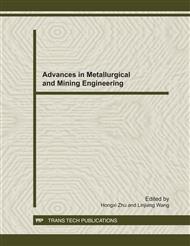p.266
p.272
p.277
p.283
p.288
p.293
p.297
p.303
p.307
Material Ratio Optimization of Low Mass Ratio of Alumina to Silica of Calcium Aluminate Slag Based on Thermodynamic Calculation Method
Abstract:
For the low m(Al2O3)/m(SiO2) (mass ratio, for short A/S) calcium aluminate slag obtained from smelting reduction Pingguo red mud, the impact of different n(CaO)/n(Al2O3))(molar ratio, for short C/A) and A/S on the separateing out phase of slag in cooling and solidification process was studied by FactSage thermodynamic calculation software, and the material ratio of the slag was optimized. The physical-chemical properties of slag prepared in the experiment were analyzed by means of XRD, EMS, EDS, Particle size analysis and Chemical analysis. The thermodynamic calculation results indicate that the effect of C/A on the phase composition of the slag is great, but the influnce of A/S from 0.5 to 1.0 is small, the material ratio optimized is C/S=2, A/S=0.5~1.0, C/A=1.61~1.81, under the conditions, the phase composition is mainly Ca2SiO4, Ca12Al14O33 and even a small amount of less than 5% of CaAl2O4 or Ca3Al2O6. The phase composition of experimental slag is consistant with that of thermodynamic calculation. In the material proportion optimized scope, the calcium aluminate slag has better the self-disintegrating and the alumina leaching performance, and satisfies completely the technological requirements of extracting alumina. The results provide the scientific basis for using the low A/S calcium aluminate slag obtained from smelting reduction Pingguo red mud producting alumina.
Info:
Periodical:
Pages:
288-292
Citation:
Online since:
November 2011
Authors:
Price:
Сopyright:
© 2012 Trans Tech Publications Ltd. All Rights Reserved
Share:
Citation:


